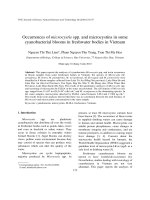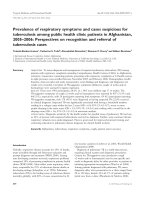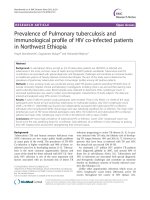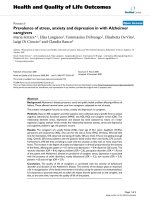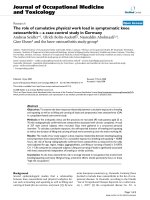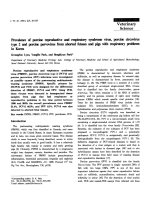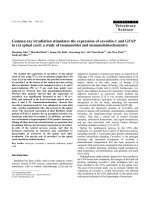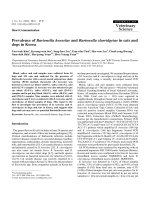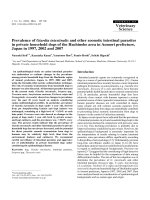Prevalence of childhood obesity and overweight in Bangladesh: Findings from a countrywide epidemiological study
Bạn đang xem bản rút gọn của tài liệu. Xem và tải ngay bản đầy đủ của tài liệu tại đây (254.75 KB, 8 trang )
Bulbul and Hoque BMC Pediatrics 2014, 14:86
/>
RESEARCH ARTICLE
Open Access
Prevalence of childhood obesity and overweight
in Bangladesh: findings from a countrywide
epidemiological study
Tania Bulbul1* and Mozammel Hoque2
Abstract
Background: Obesity has been declared an epidemic in many high income countries. In low income countries, the
coexistence of obesity and underweight makes the situation more grievous. The priority is to explore the overall
pictures of body weight status in low income countries and countries that are in transitional phase. Through this
country wide cross sectional study we would like to capture the current body weight status among the school
aged children, both in urban and rural areas in Bangladesh.
Methods: We conducted a countrywide cross sectional study, from June to September 2009. By random sampling,
we selected 10,135 students from 6 to 15 years from both the urban and rural schools. We categorized the
students into overweight, obese and underweight by using the values for age and sex at +1SD, +2SD and −2 SD of
Z scores of BMI respectively.
Results: We observed among 6 to 15 year olds from both the urban and rural areas 3.5% were obese, 9.5% were
overweight and 17.6% were underweight. The proportion of obese and overweight students were greater among
the students from urban schools (5.6%, 10.6%) compared to the students from rural schools (1.2%, 8.6%) (RD = 4.3,
95% CI = 3.6, 5.0; RD = 2.0, 95% CI = 0.1, 3.1). The proportion of underweight students were lower in the urban
schools (16.1%) compared to the rural schools (19.2%) (RD = −3.1; 95% CI = −4.6, −1.6)
Conclusions: The rate of obesity and overweight is alarming among school aged children in Bangladesh.
Overweight and underweight are coexisting which needs special attention to minimize the dual burden.
Background
The prevalence of obesity is very high in high income
countries and many of them have declared obesity an
epidemic [1,2]. In the US, obesity is considered a major
health problem. Half the population is obese; among
adults more than 60% are overweight and more than
30% are obese; among children over 17% are obese [3,4].
In the UK, among adults 23% of men and 25% of women
are obese. Among children from 2 to 15 years 5.5% of boys
and 7.2% of girls are obese and 22% of boys and 28% of
girls are overweight [5].
The low income countries are showing the same trend
as the high income countries in increasing rates of obesity.
And the duel burden households are very common where
* Correspondence:
1
Center for Communicable Diseases, International Center for Diarrheal
Disease Research, Bangladesh, Dhaka, Bangladesh
Full list of author information is available at the end of the article
underweight and overweight coexist among the children
[6]. Rapid urbanization and industrialization are changing
the food habits resulting in socio-economic, demographic
and cultural changes leading to nutritional transition in
low income countries [7,8].
To combat the burden of obesity different stakeholders
have taken a variety of strategies to address diet, physical
activity and health. Particularly for low-income countries
or countries which are in a transitional phase, undernutrition is still prevalent, and control of obesity will be
an additional burden [9].
The proportions of obesity among women in Bangladesh,
and the related health and social problems has already
been addressed in several studies [10,11]. However, there
is a lack of national data for overall body weight status of
school aged children. Through this country wide cross
sectional study we would like to capture the current body
© 2014 Bulbul and Hoque; licensee BioMed Central Ltd. This is an Open Access article distributed under the terms of the
Creative Commons Attribution License ( which permits unrestricted use,
distribution, and reproduction in any medium, provided the original work is properly credited. The Creative Commons Public
Domain Dedication waiver ( applies to the data made available in this
article, unless otherwise stated.
Bulbul and Hoque BMC Pediatrics 2014, 14:86
/>
weight status of school aged children both in urban and
rural areas in Bangladesh.
Methods
We conducted a countrywide cross sectional study where
we selected school aged children from 6 to 15 year olds
from both the rural and urban schools in Bangladesh. We
selected 10,135 students using random sampling method.
First, we enrolled all six divisions that are the major administrative region of the country. Then we randomly
selected two districts those are the second highest tier
of regional administrative areas of the country from
each division. In the district level we stratified the areas
into urban and rural areas. The urban area, a pourasava
(municipality) having such amenities as metalled roads,
improved communication, electricity, gas, water supply,
sewerage, sanitation, and also having higher density of
population with majority population in non-agriculture
occupations [12]. During selecting a rural area, we selected randomly a sub-district from the selected district
(second lowest tier of regional administration). Then
from each sub-district we selected a union (the lowest
tier of regional administration) randomly.
From each selected union in rural area and municipality in urban area we selected one primary school and
one secondary school randomly. Thus in total, we enrolled 48 schools where 24 were primary schools and 24
were secondary schools from 12 urban and 12 rural
areas of 12 districts of the country. Based on a previous
cross sectional study considered the prevalence of childhood obesity would be close to 7.6% [13]. At the 95%
significance level and with 90% power, we would require
to enroll 4,007 students. As we enrolled all the students
of the selected school, to account for the similarity
among the students our estimated sample size was
8,014 would be sufficient considering the design effect
of 2 [14]. We collected data from June to September
2009. 36 field workers were recruited and trained to
take the body weight and height of the children. A team
of three field workers in each school measured the body
weight and height of the children at the school premises. The field worker calibrated the weight machine by
applying a random set of the standard weights daily to
roughly check the accuracy of the weight scales. While
measuring the weight the children were asked to put off
their shoes. Randomly five boys and five girls from each
class from each school were selected to take weight of
their school uniform separately and calculated the mean
weight of the school uniform by sex. Then we calculated
the actual body weight by deducting the mean weight of
school uniform from their measured body weight. For
taking the height we locally built a stadiometer and
checked the horizontal bar was firmly attached with the
sliding section before taking the measurement. While
Page 2 of 8
taking the height the children were asked to stand straight
on bare foot and to look straight in front.
We excluded the child from the study if the child had
been suffering from any mental or physical disability or
the child was foreigner or from other ethnic minority
group. We collected anthropometric measurement (body
height and weight) of all the students from the selected
schools met the inclusion criteria. We calculated BMI
(Body Mass Index) and according to BMI we categorized
students into normal weight if BMI was between overweight and underweight with respect to age and sex,
overweight if BMI was more than the standardized value
for age and sex at +1SD of Z scores of BMI, obese if
BMI was more than the standardized value for age and
sex at +2SD of Z scores of BMI and underweight if BMI
was more than the standardized value for age and sex
at -2SD of Z scores of BMI [15].
After getting the approval from Institutional Review
Board for the study, the ethical clearance had been obtained
from the Ethical Clearance Committee of Bangabandhu
Sheikh Mujib Medical University prior data collection. We
informed the parents the day before data collection
through a letter from the principal that all the students in
the school would be interviewed and their height and
weight would be measured to check their nutritional status for a study purpose. We obtained informed written
consent from the principal or principal nominated teacher
where principal was absent. All the students were thoroughly appraised about the nature, purpose and implications of the study and were also assured about their
confidentiality and freedom to withdraw themselves from
the study any time. All the data were recorded systematically in a preformed data collection sheet. Data were
analyzed by using STATA. We described baseline characteristics (age groups, sex). We calculated the proportions of body weight status of the students with 95%
confidence intervals. To compare the body weight status
among boys and girls, among the students from primary
and secondary schools and among the students from
urban and rural schools we calculated risk differences with
95% confidence intervals.
Results
We enrolled total 10,135 students; among them 4,765
students were from rural schools and 5,370 students were
from urban schools. In both urban and rural schools the
distribution of boys and girls in primary and secondary
schools were almost similar (Table 1).
This study revealed among 6 to 15 year olds from both
the rural and urban areas 3.5% (95% CI = 3.0, 4.0) were
obese, 9.5% (95% CI = 9.0, 10.0) were overweight and
17.6% (95% CI = 16.0, 18.0) were underweight (Table 2).
We observed, the proportion of obese students were
greater among the students from urban schools (5.6%)
Bulbul and Hoque BMC Pediatrics 2014, 14:86
/>
Page 3 of 8
Table 1 Baseline characteristics of the enrolled students
Rural (N = 4765) Urban (N = 5370)
Total students N = 10,135
n/N*
%
n/N*
%
2223/4765
47
2332/5370
43
Boys
1071/2223
48
1229/2332
53
Girls
1152/2223
51
1103/2332
47
Students from Primary schools
(age: 6 to 10 years) (N = 4555)
Students from secondary schools
(age: 11 to 15 years) (N = 5560)
2542/4765
53
3038/5370
57
Boys
1229/2542
48
1698/3038
56
Girls
1313/2542
52
1340/3038
44
*n = number of subjects with indicator, N = Total number of subjects.
compared to the students from rural schools (1.2%) (RD =
4.3; 95% CI = 3.6, 5.0). More students from the urban
schools (10.6%) were overweight than the students from
rural schools (8.6%) (RD = 2.0; 95% CI = 0.1, 3.1). However,
the study revealed the proportion of underweight students
was lower in the urban schools (16.1%) compared to the
rural schools (19.2%) (RD = −3.1; 95% CI = −4.6, −1.6)
(Table 3).
While comparing the students by area, among the boys
the proportion of obesity was significantly higher in urban
schools (5.6%) compared to rural schools (1.5%) (RD = 4;
95% CI = 3, 5). Similarly among the girls the proportions
of both obesity and overweight were significantly higher in
urban schools (5.5%, 11.1%) compared to rural schools
(1.0%, 3.8%) (RD = 7; 95% CI = 6, 9). However, among
the girls the proportion of underweight was significantly
lower in urban schools (12.3%) compared to rural schools
(18.5%) (RD = −6; 95% CI = −8, −4) (Table 4).
While comparing the students by sex, the proportion
of overweight among boys (11.7%) was higher compared
to girls (7.4%) (RD = 4.3; 95% CI = 3.1, 5.4). The proportion of underweight among boys (19.6%) was higher compared to girls (15.4%) (RD = 4.1; 95% CI = 2.6, 5.6). Among
the girls, the proportion of obesity was significantly lower
among 11 to 15 years olds (3.8%) compared to 6 to 10 year
olds (2.8%) (RD = −1.1; 95% CI = −0.2, −0.1). Among the
boys, the proportion of obesity was higher among 11 to
15 year olds (16.1%) compared to 6 to 10 year olds (6.1%)
(RD = 9.9; 95% CI = 8.2, 11.7). Among both the boys and
girls, the proportion of underweight was significantly
Table 2 Prevalence of obesity, overweight and
underweight among study subjects
Indicators
n/N* = 10135
%
95% Confidence interval
Obese
359
3.5
(3, 4)
Overweight
977
9.6
(9, 10)
Underweight
1780
17.6
(16, 18)
*n = number of subjects with indicator, N = Total number of subjects.
lower among 11 to 15 year olds (10.1%) compared to 6
to 10 year olds (21.8%) (RD = −11.7 95% CI = −13.7, −9.7)
(Table 5).
Discussion
The prevalence of obesity and overweight among
Bangladeshi school children of 6 to 15 year olds found
3.5% and 9.7% respectively. The available data from the
other South East Asian showed the similar rate of obesity
among school aged children [16]. Among the Saudi children from 6 to 18 year olds the prevalence of obesity and
overweight was around 6% and 12% respectively [17].
Though the rate of obesity is higher in high income countries, the rate of obesity is also increasing in low income
countries. Most studies from the high income countries
reported an increasing prevalence of obesity in childhood
and adolescence period [18]. However, in Thailand, obesity
among 6 to 12 year olds increased from 12.2% to 15.6%
in two years, between 1991 and 1993 [19]. A recent cross
sectional study conducted in Dhaka city among 5000
study subjects identified 380 children (7.6%) were obese
[13]. The proportion of obesity from this previous study
was much higher probably due to smaller sample size and
also they enrolled a subgroup of population from a metropolitan city in contrast to our countrywide sampling.
There is good evidence that the rate of childhood
obesity is increasing in low and middle income countries. Malnutrition and obesity coexist in many low income countries. According to a review article, obesity
does not appear to be public health problem among
school children in Asia and sub-Saharan Africa. However,
many countries in Latin America, Caribbean, Middle
East, North Africa, central/Eastern Europe and the common wealth of independent states, the proportions of
obesity among children are as high as they are in United
States [7,20]. Considering the large differences in sociocultural contexts of these countries and rapidity of the epidemiologic transition, the extent of childhood obesity and
overweight largely differs across countries [2].
Our study revealed high level of underweight (17.6%)
among 6 to 15 year olds. An analysis of 160 nationally
representative surveys from 94 low income countries
showed an increasing rate of overweight and obesity
among the obese children from childhood to adulthood,
although rates of early childhood malnutrition remained
relatively high. Certain countries demonstrated high
prevalence of overweight in conjunction with high frequencies of malnutrition. In northern Africa, the proportion of overweight children exceeded 8% and that of
children with wasting exceeded 7%. Similarly in south
east-Asia, 2.4% of preschool children are overweight
and 10.4% suffers from wasting [21]. However, another
review article with based on nationally representative
data from Brazil, China, United States of America and
Bulbul and Hoque BMC Pediatrics 2014, 14:86
/>
Table 3 Body weight status among primary and secondary schools students in urban and rural areas
Urban
Total number
of students
Indicators
Obese
N = 5370 n (%)* N = 2332 n (%)*
300 (5.6)
Rural
Primary school Secondary school Comparison between
primary and
students
students
secondary students
(6 to 10 years) (11 to 15 years)
173 (7.4)
N = 3038 n (%)*
RD (95% CI)†
127 (4.2)
−3.2 (−4.4, −2.0)
Total number
of students
Comparison between Comparison between
Secondary
Primary school
students from urban
primary and
school students
students
and rural areas
(6 to 10 years) (11 to 15 years) secondary students
N = 4765 n (%)* N = 2223 n (%)*
59 (1.2)
21 (0.9)
N = 2542 n (%)*
RD (95% CI)†
RD (95% CI)†
38 (1.5)
0.6 (−0.1, 1.2)
4.3 (3.6, 5.0)
Overweight
597 (10.6)
234 (10.0)
333 (11.0)
1.0 (−0.7, 2.6)
410 (8.6)
60 (2.7)
350 (13.8)
11 (9.5, 12.6)
2.0 (0.1, 3.1)
Underweight
865 (16.1)
453 (19.4)
412 (13.6)
−5.9 (−7.8, −3.9)
915 (19.2)
605 (27.2)
310 (12.2)
−15 (−17.2, −12.8)
−3.1 (−4.6, −1.6)
*n = number of subjects with indicator, N = Total number of subjects.
†
RD = Risk difference indicates the difference of proportions of indicators among the comparison groups. Positive sign (+) denotes, obesity/ overweight/underweight are more common among the children from urban
schools than the children from rural schools and more common among the children from secondary schools than the primary schools; negative sign (−) is less common.
Page 4 of 8
Bulbul and Hoque BMC Pediatrics 2014, 14:86
/>
Table 4 Body weight status among the boys and girls in urban and rural schools
Urban schools
Rural schools
Boys
Girls
Comparison between
boys and girls
Boys
Girls
Comparison between
boys and girls
Comparison among
boys between urban
and rural schools
Comparison among
girls between urban
and rural schools
N = 2927 n (%)*
N = 2443 n (%)*
RD (95% CI)†
N = 2300 n (%)*
N = 2465 n (%)*
RD (95% CI)†
RD (95% CI)†
RD (95% CI)†
Obese
165 (5.6)
135 (5.5)
0.001 (−0.01, 0.01)
35 (1.5)
24 (1.0)
0.01 (−0.001, 0.01)
4 (3, 5)
5 (4, 6)
Overweight
296 (10.1)
271 (11.1)
−0.01 (−0.03, 0.01)
317 (13.8)
93 (3.8)
10 (8.4, 11.6)
−4, (−5, −2)
7 (6, 9)
Underweight
564 (19.3)
301 (12.3)
7 (5, 9)
458 (19.9)
457 (18.5)
1 (−0.01, 0.04)
−0.01 (−3, 2)
−6 (−8, −4)
Indicators
*n = number of subjects with indicator, N = Total number of subjects.
†
RD = Risk difference indicates the difference of proportions of indicators among the comparison groups. Positive sign (+) denotes, obesity/ overweight/underweight are more common among the children from urban
schools than the children from rural schools and more common among the boys than the girls; negative sign (−) is less common.
Page 5 of 8
Bulbul and Hoque BMC Pediatrics 2014, 14:86
/>
Table 5 Body weight status among the primary and secondary school students among boys and girls irrespective of area
Boys
Total number
of boys
Indicators
Obese
Girls
Primary students
Secondary
Comparison among the
(6 to 10 years) (11 to 15 years) boys between primary
and secondary students
Total number
of girls
Primary students Secondary students Comparison among the Comparison
(6 to 10 years)
(11 to 15 years)
girls between primary between boys
and girls
and secondary students
N = 5227 n (%)*
N = 2300 n (%)*
N = 2927 n (%)*
RD (95% CI)†
N = 4908 n (%)*
N = 2255 n (%)*
N = 2653 n (%)*
RD (95% CI)†
RD (95% CI)†
200 (3.8)
108 (4.7)
92 (3.1)
−1.5 (2.6, −0.5)
159 (3.2)
86 (3.8)
73 (2.8)
−1.1 (−0.2, −0.1)
0.6 (−0.1, 1.3)
Overweight
613 (11.7)
141 (6.1)
472 (16.1)
9.9 (8.2, 11.7)
364 (7.4)
153 (6.8)
211 (8)
1.2 (−0.3, 2.6)
4.3 (3.1, 5.4)
Underweight
1022 (19.6)
567 (24.7)
455 (15.5)
−9.1 (−11.2, −7.0)
758 (15.4)
491 (21.8)
267 (10.1)
−11.7 (−13.7, −9.7)
4.1 (2.6, 5.6)
*n = number of subjects with indicator, N = Total number of subjects.
†
RD = Risk difference indicates the difference of proportions of indicators among the comparison groups. Positive sign (+) denotes, obesity/ overweight/underweight are more common among the boys than the girls
and more common among the children from secondary schools than the primary schools; negative sign (−) is less common.
Page 6 of 8
Bulbul and Hoque BMC Pediatrics 2014, 14:86
/>
Russia showed the inverse relationship of co-existence
of overweight and underweight [22].
This study revealed, more boys were both overweight
and underweight compared to girls among 6 to 15 year
olds. A cross sectional survey in Lebanon showed prevalence of childhood obesity much higher in boys (7.5%)
than the girls (3.2%) among 3 to 19 year olds [23]. Another study on the Finish children observed greater rate
of overweight and obesity among the boys than the girls
[24]. In USA, boys were more at risk for overweight than
the girls among 6 to 19 year olds [3]. However, the sex
distribution varies among the ethnic groups. Another
study in USA showed more girls were overweight and
obese among the non-Hispanic black children than the
boys among 12 to 19 year olds [25].
Compared to rural children among 6 to 15 year olds,
the study revealed more children in the urban schools
were overweight and obese. From a cross-sectional study
was performed on 541 children (273 boys and 268 girls)
aged 6–7 years, in urban and rural areas of South-East
Serbia found more obese children in urban areas than
the rural areas. This difference ascribed to more sweets
and fast food consumption and spending time in watching
TV among the urban children compared to rural children
[26]. Another study in China showed that the rate of
childhood obesity is more in urban children (23-30%) than
in rural children (16-20%) and the difference was not only
because of that the children in rural China are physically
more active but also the reason is the urban children
consume more fat than rural children. Urban children
in China are engaged in more academic work because
they are under pressure to achieve scholastic excellence,
whereas rural Chinese children are engaged more in
physical work to meet economic necessity [27].
Lower to middle income nations face double burden of
having both malnourished and over nourished populations, where overweight and obese children being concentrated in urban areas mostly. In developing countries, the
rapid progress of urbanization is associated with a cluster
of non-communicable diseases and unhealthy lifestyles,
which results in very high rates of obesity and its consequent morbidity and mortality. Moreover, in such communities, childhood obesity is still considered a sign of
healthiness and high social class [28].
Conclusions
The prevalence of obesity and overweight is alarming
among the school aged children in Bangladesh. While
underweight is still predominating among the rural children, obesity and overweight prevailing among the urban
children. To combat the future dual burden of communicable diseases and the non-communicable diseases as
a consequence of underweight and overweight, we need
to understand the social perspective of overweight and
Page 7 of 8
obesity in the low income countries in order to take
appropriate measure by the government and other
stakeholders.
Competing interests
The authors declare that they have no competing interests.
Authors’ contributions
TB conceptualized, designed, analyzed data and wrote the manuscript. MH
contributed in study design and writing. And also have given final approval
of the version to be published. Both authors read and approved the final
manuscript.
Authors’ information
Tania Bulbul, MD, MPH, Assistant scientist, CCD, icddr,b, Dhaka, Bangladesh
Dr. Md. Mozammel Hoque, Professor, Department of Biochemistry,
Bangabandhu Sheikh Mujib Medical University, Dhaka, Bangladesh.
Acknowledgements
This study was supported by the University Grant Commission, Bangladesh.
The authors thank all the data collectors, study participants and the
headmasters of the selected schools for permitting to conduct the study.
Author details
1
Center for Communicable Diseases, International Center for Diarrheal
Disease Research, Bangladesh, Dhaka, Bangladesh. 2Departmet of
Biochemistry, Bangabandhu Sheikh Mujib Medical University, Dhaka,
Bangladesh.
Received: 7 September 2013 Accepted: 28 March 2014
Published: 1 April 2014
References
1. Hill JO, Peters JC: Environmental contributions to the obesity epidemic.
Science 1998, 280(5368):1371–1374.
2. James PT, Leach R, Kalamara E, Shayeghi M: The worldwide obesity
epidemic. Obes Res 2001, 9(S11):228S–233S.
3. Hedley AA, Ogden CL, Johnson CL, Carroll MD, Curtin LR, Flegal KM:
Prevalence of overweight and obesity among US children, adolescents,
and adults, 1999–2002. JAMA: J Am Med Assoc 2004, 291(23):2847–2850.
4. Ogden CL, Carroll MD, Kit BK, Flegal KM: Prevalence of obesity in the United
States, 2009–2010. NCHS data brief, no 82. Hyattsville, MD: National Center for
Health Statistics: US Department of Health and Human Services, Centers for
Disease Control and Prevention, National Center for Health Statistics; 2012.
5. Rennie KL, Jebb SA: Prevalence of obesity in Great Britain. Obes Rev 2005,
6(1):11–12.
6. Doak CM, Adair LS, Bentley M, Monteiro C, Popkin BM: The dual burden
household and the nutrition transition paradox. Int J Obes 2004,
29(1):129–136.
7. Monteiro CA, Conde WL, Popkin BM: The burden of disease from
undernutrition and overnutrition in countries undergoing rapid nutrition
transition: a view from Brazil. Information: Journal; 2004:94(3).
8. Popkin BM: The nutrition transition in low†income countries: an
emerging crisis. Nutr Rev 1994, 52(9):285–298.
9. Chopra M, Galbraith S, Darnton-Hill I: A global response to a global
problem: the epidemic of overnutrition. Bull World Health Organ 2002,
80(12):952–958.
10. Shafique S, Akhter N, Stallkamp G, de Pee S, Panagides D, Bloem MW:
Trends of under-and overweight among rural and urban poor women
indicate the double burden of malnutrition in Bangladesh. Int J Epidemiol
2007, 36(2):449–457.
11. Martorell R, Khan LK, Hughes ML, Grummer-Strawn LM: Obesity in women
from developing countries. Eur J Clin Nutr 2000, 54(3):247–252.
12. Bbs: Statistical year book of Bangladesh. In Bangladesh Bureau of Statistics,
Ministry of Planning. Dhaka, Bangladesh: Government of the People’s
Republic of Bangladesh; 2009.
13. Rahman IK SMM, Khaled MA, Bhuyan MAH, Harun-Ar-Rashid, Malek MA,
aMRK: Prevalence and determinants of childhood obesity in Dhaka City.
In ASCON, Volume 10. Edited by Chair PT, Ansari A, Islam MS, Khan MSI,
Osinski P, Rabbani GH, Rahim MA, Roy SK. Dhaka, Bangladesh: icddr,b;
2002:161.
Bulbul and Hoque BMC Pediatrics 2014, 14:86
/>
Page 8 of 8
14. Killip S, Mahfoud Z, Pearce K: What is an intracluster correlation
coefficient? Crucial concepts for primary care researchers. Ann Fam Med
2004, 2(3):204–208.
15. Onis M, Onyango AW, Borghi E, Siyam A, Nishida C, Siekmann J:
Development of a WHO growth reference for school-aged children and
adolescents. Bull World Health Organ 2007, 85(9):660–667.
16. Jafar TH, Qadri Z, Islam M, Hatcher J, Bhutta ZA, Chaturvedi N: Rise in
childhood obesity with persistently high rates of undernutrition among
urban school-aged Indo-Asian children. Arch Dis Child 2008, 93(5):373–378.
17. El-Hazmi MAF, Warsy AS: The prevalence of obesity and overweight in
1-18-year-old Saudi children. Ann Saudi Med 2002, 22(5/6):303–307.
18. Wang Y, Lobstein T: Worldwide trends in childhood overweight and
obesity. Int J Pediatr Obes 2006, 1(1):11–25.
19. Mo-suwan L, Junjana C, Puetpaiboon A: Increasing obesity in school
children in a transitional society and the effect of the weight control
program. Southeast Asian J Trop Med Public Health 1993, 24(3):590.
20. Monteiro CA, Moura EC, Conde WL, Popkin BM: Socioeconomic status and
obesity in adult populations of developing countries: a review. Bull World
Health Organ 2004, 82(12):940–946.
21. De Onis M, Blossner M: Prevalence and trends of overweight among
preschool children in developing countries. Am J Clin Nutr 2000,
72(4):1032–1039.
22. Wang Y, Monteiro C, Popkin BM: Trends of obesity and underweight in
older children and adolescents in the United States, Brazil, China, and
Russia. Am J Clin Nutr 2002, 75(6):971–977.
23. Sibai AM, Hwalla N, Adra N, Rahal B: Prevalence and covariates of obesity
in Lebanon: findings from the first epidemiological study. Obes Res 2003,
11(11):1353–1361.
24. Kautiainen S, Rimpela A, Vikat A, Virtanen SM: Secular trends in overweight
and obesity among Finnish adolescents in 1977–1999. Int J Obes Relat
Metab Disord: J Int Assoc Study Obes 2002, 26(4):544–552.
25. Ogden C, Carroll M: Prevalence of obesity among children and
adolescents: United States, trends 1963–1965 through 2007–2008.
Center Dis Control Prevent Natl Center Health Statistics 2010, 201(0):1–5.
26. Stojanovic D, Belojevic G: Prevalence of obesity among children aged
6–7 years in South-East Serbia. Obes Rev 2009, 10(3):262–264.
27. Cheng TO: Obesity in Chinese children. JRSM 2004, 97(5):254.
28. Kelishadi R: Childhood overweight, obesity, and the metabolic syndrome
in developing countries. Epidemiol Rev 2007, 29(1):62–76.
doi:10.1186/1471-2431-14-86
Cite this article as: Bulbul and Hoque: Prevalence of childhood obesity
and overweight in Bangladesh: findings from a countrywide
epidemiological study. BMC Pediatrics 2014 14:86.
Submit your next manuscript to BioMed Central
and take full advantage of:
• Convenient online submission
• Thorough peer review
• No space constraints or color figure charges
• Immediate publication on acceptance
• Inclusion in PubMed, CAS, Scopus and Google Scholar
• Research which is freely available for redistribution
Submit your manuscript at
www.biomedcentral.com/submit
